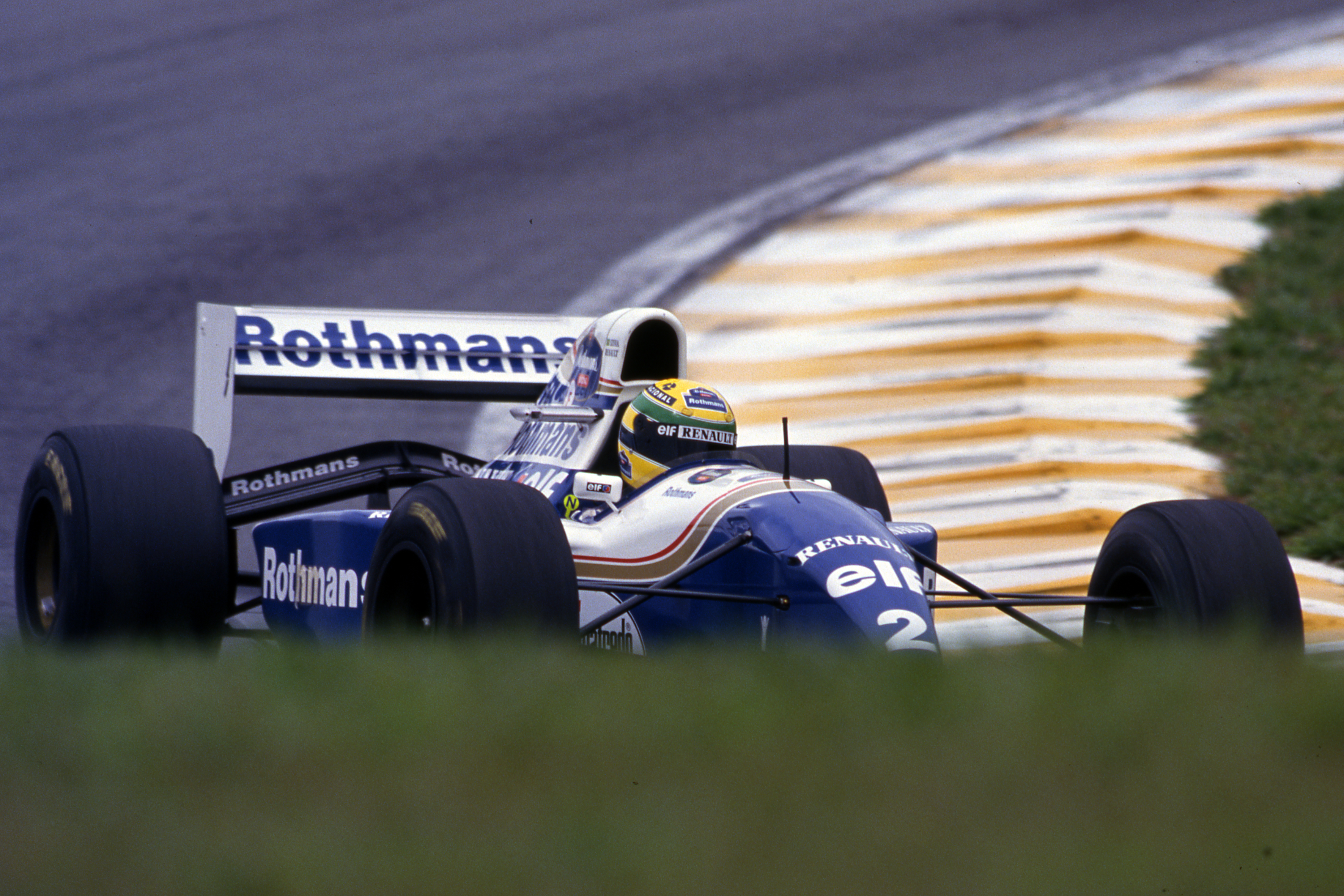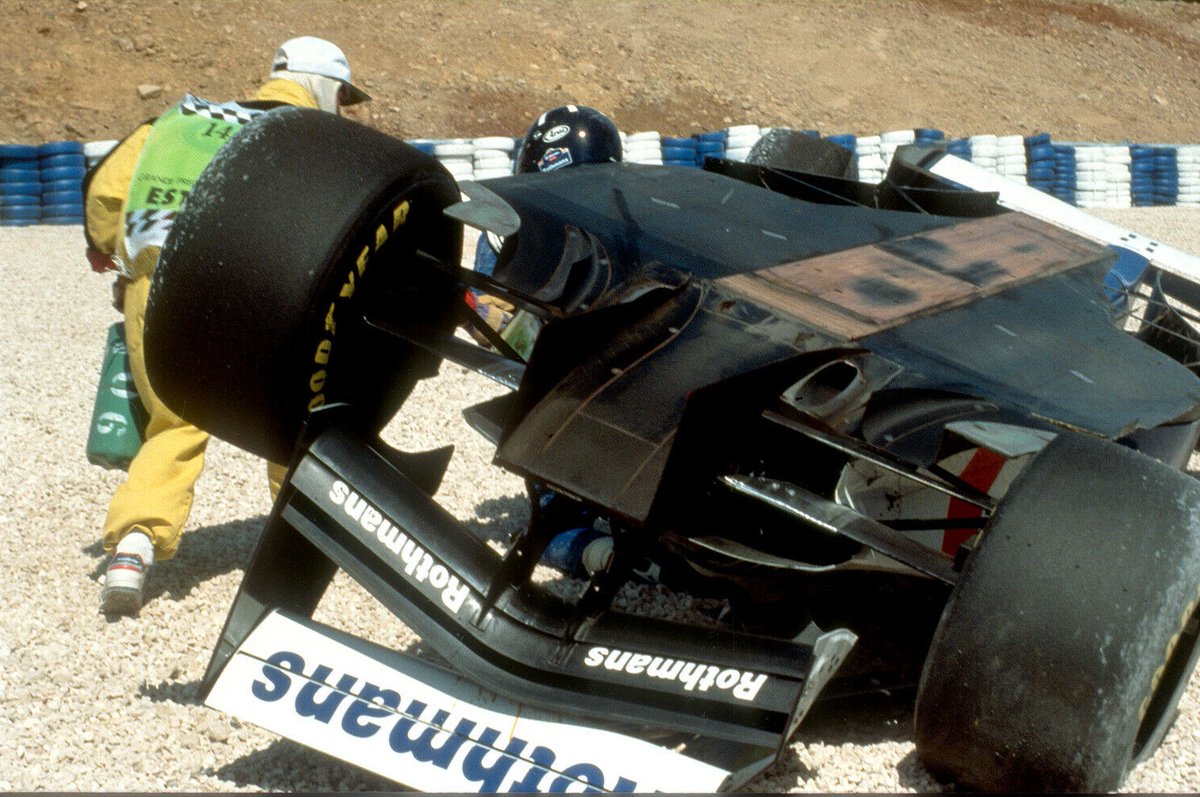
- Login or Register
No account yet? Sign up

Interestingly, the B194 of that same year also had that style of beam wing, albeit to a lesser extend. The B195 did too, although to a greater extent that the B194.AR3-GP wrote: ↑17 Jul 2023, 18:11The beam wing on the '94 Williams. Not 100% bizzare, but interesting nonetheless.
https://storage.googleapis.com/the-race ... _HiRes.jpg

Remember that the FW16 ran on its belly - they were still flat bottomed cars then so there was very little scope for tyre squirt to affect the diffuser, and the exhausts blowing in to the innermost of the small channels probably made any tyre squirt effects pretty negligible anyway.Farnborough wrote: ↑17 Jul 2023, 22:02On the inverted one, notice also the shear volume of airflow between the inner face of rear tyre and a very small diffuser on that car. This seems a big interest area in AN concept and keeps repeating, appears to be substantial benefit but everyone mostly looks at diffuser internal and size.

That is an interesting point, I seem to remember that after that (for ‘95, I think) they went the other way and the lower suspension arm was inline with the drive-shaft. There was an admission by someone senior that mechanically/kinematically it was sub-optimal, but aerodynamically advantageous.Farnborough wrote: ↑17 Jul 2023, 22:02
Notice the rear suspension all arranged in space between driveshaft downwards for airflow on that car. It's more or less the opposite on current AN design, also sharing pushrod actuation in both design.
There wasn't any benefit in having a current style "high mounted" rear suspension - the diffuser height didn't require it. But making the top wishbone in line with the driveshaft meant the flow to the beam wing was good.Farnborough wrote: ↑17 Jul 2023, 22:02Notice the rear suspension all arranged in space between driveshaft downwards for airflow on that car. It's more or less the opposite on current AN design, also sharing pushrod actuation in both design.



Right from season start they seemed to struggle with it, and did appear to have a rather flexible range in controlling wheel camber during maximum lateral load peaks.Stu wrote: ↑17 Jul 2023, 22:26That is an interesting point, I seem to remember that after that (for ‘95, I think) they went the other way and the lower suspension arm was inline with the drive-shaft. There was an admission by someone senior that mechanically/kinematically it was sub-optimal, but aerodynamically advantageous.Farnborough wrote: ↑17 Jul 2023, 22:02
Notice the rear suspension all arranged in space between driveshaft downwards for airflow on that car. It's more or less the opposite on current AN design, also sharing pushrod actuation in both design.
All very interesting pictures with some good detail there.Just_a_fan wrote: ↑17 Jul 2023, 22:41There wasn't any benefit in having a current style "high mounted" rear suspension - the diffuser height didn't require it. But making the top wishbone in line with the driveshaft meant the flow to the beam wing was good.Farnborough wrote: ↑17 Jul 2023, 22:02Notice the rear suspension all arranged in space between driveshaft downwards for airflow on that car. It's more or less the opposite on current AN design, also sharing pushrod actuation in both design.
https://i.ibb.co/kx5SkyZ/image-2023-07-17-214114108.png
https://i.ibb.co/0sLYqLY/image-2023-07-17-214602598.png
Airflow over the diffuser was obviously treated differently - there's a very noticeable Gurney flap on the trailing edge upper surface just behind the lower wishbone.
Lovely to see these details. I suspect a much larger diffuser was needed since they didn't introduce the side walls, let alone strakes inside the diffuser itself.Just_a_fan wrote: ↑17 Jul 2023, 22:57Compare the Williams diffuser to the McLaren MP4/1C - only 9 years earlier.
https://i.ibb.co/k3vBk3n/image-2023-07-17-215629691.png
It's a massive, and massively crude, device, isn't it?Vanja #66 wrote: ↑18 Jul 2023, 09:45Lovely to see these details. I suspect a much larger diffuser was needed since they didn't introduce the side walls, let alone strakes inside the diffuser itself.Just_a_fan wrote: ↑17 Jul 2023, 22:57Compare the Williams diffuser to the McLaren MP4/1C - only 9 years earlier.
https://i.ibb.co/k3vBk3n/image-2023-07-17-215629691.png


Yeah, those are some wonderful details there. I really like that period, a lot of hands-on engineering, on-track testing, trying to understand the car through feeling rather than hard data - since you can't really get the hard aero data like you can now.Just_a_fan wrote: ↑18 Jul 2023, 10:10It's a massive, and massively crude, device, isn't it?
Interesting to see the development of this area in the McLaren.
The next car, the MP4/2C had blown diffuser with a small side strake but still mostly open (and a huge gearbox lump).
https://i.ibb.co/Vjpz70z/image-2023-07-18-090052848.png
The MP4/4 still had a blown diffuser but this time the gearbox intrusion was much less and the blown diffuser section was fully walled by a strake and the gearbox enclosure. Still had a large open-sided region by the tyre, however.
https://i.ibb.co/xCrLPHc/image-2023-07-18-090236544.png
I would guess that the open-sided section actually helped to lift the tyre squirt and thus helped to reduce air movement under the diffuser strakes.
I do find it amusing how "crude" these cars look to modern eyes, but also am amazed at how effective they were with the tools they had available to them at the time.
It would be brilliant to see someone remake the MP4/4, for example, but with modern aero refinements and materials/techniques - I wonder how much time they could find compared to the original.
This type of diffuser was called an "undercut diffuser". Williams introduced it in Portugal in 1995, as far as I remember correctly. It had a larger extraction volume because it exploited a gray area in the regulations, and it was the reason for Williams' big downforce advantage in 1995, 1996, and 1997. It was also the first diffuser where the lower triangular wishbone didn't run through the diffuser and side channels. The other teams, like Ferrari, McLaren and Benetton discovered the real "secret" of this diffuser only during the 1997 season. It was a great time in which Ferrari in particular was the absolute leader in this area at the beginning of the 2000s, using more and more vortices and achieving ever greater angles of attack of the diffuser.Just_a_fan wrote: ↑17 Jul 2023, 22:41There wasn't any benefit in having a current style "high mounted" rear suspension - the diffuser height didn't require it. But making the top wishbone in line with the driveshaft meant the flow to the beam wing was good.Farnborough wrote: ↑17 Jul 2023, 22:02Notice the rear suspension all arranged in space between driveshaft downwards for airflow on that car. It's more or less the opposite on current AN design, also sharing pushrod actuation in both design.
https://i.ibb.co/kx5SkyZ/image-2023-07-17-214114108.png
https://i.ibb.co/0sLYqLY/image-2023-07-17-214602598.png
Airflow over the diffuser was obviously treated differently - there's a very noticeable Gurney flap on the trailing edge upper surface just behind the lower wishbone.